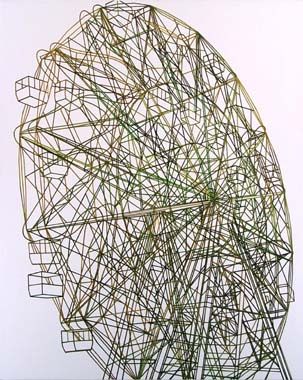William Steiger
dal 5/5/2002 al 24/8/2002
Segnalato da
5/5/2002
William Steiger
Queens Museum of Art, New York
Steiger paintings allow his imagination and our collective memory merge to shape "reality." Steiger's subjects are bridges, towering structures, and flying machines from the first half of the 20th century. He often paints these magnificent constructions that once epitomized progress and technology, as well as landscapes from an aerial perspective.

Queens Museum of Art @ Bulova Corporate Center presents
William Steiger
130 ft high, 65 thou gal, 1/2 mile deep...
William Steiger paintings allow his imagination and our
collective memory merge to shape "reality." Steiger’s
subjects are bridges, towering structures, and flying
machines from the first half of the 20th century. He often
paints these magnificent constructions that once epitomized
progress and technology, as well as landscapes from an
aerial perspective. Parachute Drop (2002) elicits the viewer’s
awe with the grandeur of its physical presence and the
dazzling beauty of an intricate iron web rendered in an
exaggerated upward perspective. However, Steiger’s revisit
to Precisionism does not replicate Charles Sheeler’s
celebration of the industrial sublime. Instead, he willfully
guides the viewer to what has become peripheral in today’s
American consciousness. His paintings are meditations on
the remnants of technology not without irony or sentiment
over lost innocence.
Tunnel (2000-2001) is a line-rendered geometry that
deceptively resembles digital imaging. While Steiger’s
emphasis on line and stoic color scheme makes a crisp
realism, it often lapses into abstraction with his idiosyncratic
formal reduction: partially abbreviated contour-lines confuse
the spatial depth of the picture plane in Oil Derrick (2002); ghostly traces of reworkings remain visible on the
canvas in Crane (2002). Steiger’s pictorial obliteration of lines and planes is a system that defies a clear-cut
literalness and asserts the subject through memory.
Steiger’s paintings never suggest the presence of a living soul and the skies are ascetically rendered like a
bright vacuum. As a result, many of the objects in his depiction appear seductively anthropomorphic--as if
they are portraits rather than landscapes about human aspirations and the idealism of the modern era.
Steiger’s industrial relics do not exist to evoke a sense of nostalgia about heroic modernity, but to signal our
shifting perception on the iconic visions of Americana now and then.
Hitomi Iwasaki, Associate Curator
Queens Museum of Art
Bulova Corporate Center 75-20 Astoria Blvd, Jackson Heights, Queens NY
Opening Reception: Monday, May 6, 5:00 - 8:00 pm
Gallery Hours
Monday - Friday 7:00 a.m. - 5:00 p.m.
Saturday 10:00 a.m. - 4:00 p.m.



